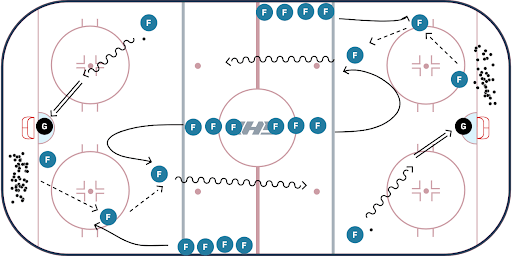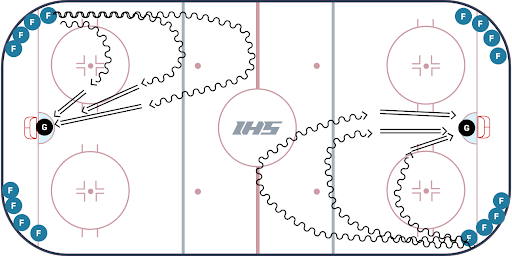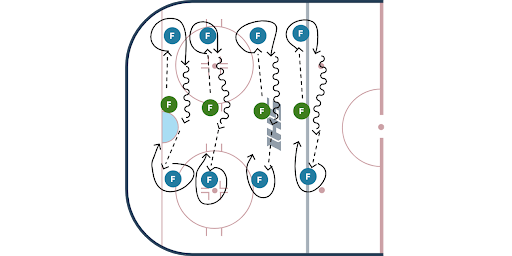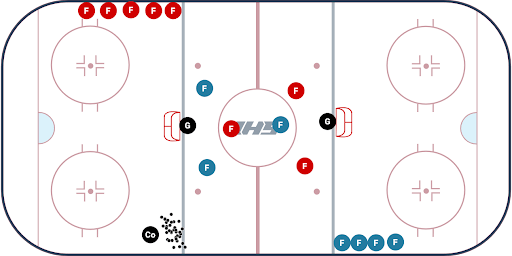Featured courses
- Complete Youth Hockey Practice Plan by Jacob Crabtree
- Zone Entry Hockey Drills: How to Teach Effective Entries by Jackson Chlebowy
- Hockey Practice Plan: Maximize Development in Every Session by Jackson Chlebowy
- Strength and Conditioning for Ice Hockey: Building the Complete Athlete by Jackson Chlebowy
- Hockey Defensive Positioning: Skills for Forwards and Defensemen by Jackson Chlebowy
- Which Hockey Position Should I Play? | Hockey Positions Guide by Jackson Chlebowy
- 3 Keys to Hockey Defense: Dominate the Defensive Zone by Jackson Chlebowy
- 4 Hockey Skating Drills for Youth Players: Building Speed, Balance, and Agility by Jackson Chlebowy
- 4 Hockey Passing Drills to Improve Team Performance: Mites to Peewees by Jackson Chlebowy
- Mastering the Hockey Forecheck: 6 Keys and Strategies by Jackson Chlebowy
- How To Coach Hockey: Creating a Winning Culture by Jackson Chlebowy
- 5 Principles of a Successful Hockey Power Play by Jackson Chlebowy
- Three Youth Hockey Shooting Drills to Score More Goals by Jackson Chlebowy
- 3 Hockey Battle Drills to Improve Compete Level and Team Chemistry by Jackson Chlebowy
- Ice Hockey Goalie Drills: Mastering the Basics by Emma Martin
- Tips and Tricks on Perfecting Your Hockey Slap Shot by Emma Martin
- 7 Effective Puck Protection Drills for Defenseman by Jacob Crabtree
- Strength and Conditioning: Tony Greco's Principles of Strength by Jacob Crabtree
- From Humble Beginnings to Highly Respected NHL Shooting Coach – A Sit-down with Tim Turk by Slava Paller
- Journey into Strength and Conditioning with NHL athletes to everyday people with Ryan Van Asten: Two time Stanley Cup Champion and Current Calgary Flames Strength and Conditioning Coach by Clarence Paller

Complete Youth Hockey Practice Plan
Young hockey players can be challenging to build practices around, which is exactly why we made the complete practice plan. This full practice plan will employ youth players with skills and abilities in every section of the ice, all while having fun, the most important part of the game!
This plan has been fully developed to build your entire practice, starting from warm-up drills all the way up to small area games to finish off the practice. These may be basic, but none the else very essential when producing a practice.
Here is the full youth practice plan for any team.
________________________________________________________________________________________________________________
Warm-up Drills:
Drill 1: Canada Cup

Canada Cup is a very well-known drill that wakes every player up including goalies for the rest of practice.
A line of players is diagonal to each other on the blue lines facing the offensive zone, and a line of players is positioned in the middle of the blue line also facing the net. On both ends of the ice.
One player on each side starts the drill by coming and taking a shot at the goalie.
Proceeds to pick up a puck behind the net and makes a pass to the player coming down from the blue line.
The player who receives the puck stays along the blue line, picks up his head aware of the other player swinging with speed, and makes a pass so the swinging player is skating out of the zone with pace.
The player who swung to get the puck takes the puck down to the other end, takes a shot on goal, then becomes the person who makes the pass to the player on the boards.
Creating a very simple and effective drill that engages all three players simultaneously, and most importantly goalies.
Drill 2: 3 Circle Loop

Another simple shooting drill that’s centered around getting goalies warmed up for the rest of practice.
Players can be positioned in all four corners of the ice, starting in opposite corners to prevent collisions.
Three players start skating with the puck, one goes around the top of the faceoff circle, another goes up to the blue line, and the third player goes up to the red line.
When the player gets to a respectable shooting range, the players take their shots and stand in front of the net, following their rebounds.
The three players then proceed to get back into line once the third player shoots, and the rebound is dead. Enforcing the other lines to go.
Very simple drill, but it teaches young players how to get their heads up when skating with the puck. So they can appropriately warm up the goalies, but also not hit their teammates in front of the net.
Drill 3: 4 Blue Line Cut

4 blue-line cut enables players to think quickly and make good passes to players so they can keep moving with speed through the zone.
One line of players is positioned at each blue line.
Diagonal lines to each other start the drill, where the first players in line come across the blue line and make a pass to the first person in line.
The first player in line gives the puck back to he/she who started the drill, and then that player makes another pass to the next line as they skate.
The player who started the drill then looks up to the line where they started and gets a pass from that line.
The last line to receive the pass makes a crisp pass to the streaking player who started the drill from their line. In that, wherever the player started the drill, the first person in line makes a breakaway pass to that player.
Once that player receives the puck they go in and take a shot on goal, and get back into line.
Good flow drill, teaching players how to lead each other when they’re on breakaways, rather than passing in each other's skates.
________________________________________________________________________________________________________________
Station Drills:
Drill 1: 2 v 2 Corner Battle

This battle drill employs players with the ability to move and create space in a small area.
A net is positioned in one corner of the offensive zone, and players are lined up on both sides of the net. Borders are set up on the boards to prevent the puck from getting out of the zone and limiting room for players to move.
Two players from either team are in the zone, making a 2 on 2 battle for possession.
The players within the zone try to create scoring chances and pass to their teammates while also trying to be physical with the other team when playing defense.
To make the drill more competitive coach could also make it one on one, and players can pass to their lines to activate more players.
Very effective drill in teaching young players how to move quickly in limited space to get open and protect the puck.
Drill 2: Stationary Power Play + Net Drive

This drill is very simple but demonstrates to young players how the power play should be set up, and how to complete good passes to teammates.
A line of players is set up in one corner. A defenseman is positioned on the blue line same side as the line in the corner, another defenseman is within a respectable distance of the near-side defenseman, another player on the hash marks along the far-side boards and one more down below the goal line.
The drill starts as the first player in line makes a pass to the defenseman at the blue line. Then proceeds to drive the net, timing when the far-side defenseman is going to shoot. The near-side defenseman makes a pass to the far-side defenseman and takes a shot on the net looking for a tip from the player who drove the net.
Once the puck and rebound are dead, the player who went to the front of the net then goes up the slot.
The next player in line makes a pass to the defenseman on the near side but continues to stay in line. Then that defenseman makes a crisp pass to the far-side defenseman, who makes a pass to the person near the boards on the hash marks, collects, and makes a pass to the player down low.
The player down low gathers the puck and makes a good catchable pass to the player in the slot.
He/she takes a quick shot, follows the rebound, and takes the place of the player down low.
The player who was down low moves up to the hash marks, the player from the boards rolls up to the far-side defenseman, and the far-side defenseman moves to the near side. The near-side defenseman goes back into line.
A drill that has a little bit of everything, but most importantly breaks the powerplay down to simple movements that can be employed in game-like situations.
Drill 3: Passing Figure 8’s

Another passing central drill, but teaches players how to make tight turns and quick passes.
Coach sets up several groups of three and positions them all somewhat close together.
One player is between the other two players who are spaced out, about a faceoff dot to faceoff dot distance away
The player in the middle has a puck and starts skating towards one player, makes a pass to that player does a tight turn around them, gets the puck back, and does the same exercise with the other partner.
Players can be creative and pass among the stationary players or have a certain number before the player turns.
Creating a figure eight with consistent passes between partners.
Once the coach blows the whistle, one of the two players who have not been in the middle switches places, and so on once all three have been in the middle.
________________________________________________________________________________________________________________
Small Area Games
Drill 1: Center Ice 2 v 1 Possession

A line of players is on opposite sides of the blue line, determining the teams.
Nets are set up at the blue lines.
Technically there are three players on each team, but one of the players has a different role than the other two teammates.
How the drill is set up is that one defenseman from each team is restricted to staying within the circle at center ice on a distinct side of the red line.
Where that defenseman is trying to take away passing lanes from the two players on his/her side and try to get the puck over to the offensive players.
The coach can dump as many pucks in as they wish, and one goal is equal to the offensive players scoring a goal on the goalie.
A very fun drill, that can get competitive, but most importantly teaches players how to create passing lanes and build teamwork.
Drill 2: Back-to-Back Nets + Point Man

Nets are positioned in the middle of the offensive zone, back to back.
Two teams are lined up on either side of the blue line.
One player from either team is positioned as the point man in front of their offensive net.
The coach dumps a puck in, and two or three players from both teams go, depending on whether the coach wants to do 2-v-2 or 3-v-3.
Players battle for possession and have to pass to the point man in order to initiate an offensive attack.
The point man can either take a shot looking for his/her teammates in front or look to make passes to other teammates. Players can use their point man as much as they like.
Another fun drill teaching young players to pick up their heads and create scoring chances for their teams, and also teaches point guys not to miss the net when shooting
Drill 3: Coaches Poker
Teams are on both benches, with one coach per bench.
A coach dumps a puck into center ice, but coaches on both benches tell their players how many are going to go.
Hopefully guessing to have more players than the other team, coaches can pick between 1-5 players.
So it could range from 5 on 5 to 5 on 1, you never know what the other team is going to do, which makes it fun.
A very fun drill that’s quickly paced and familiarizes players to take advantage of having a man advantage or playing defense with fewer players than the other team.
